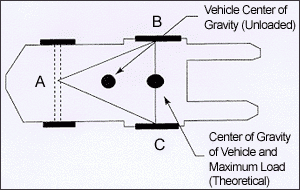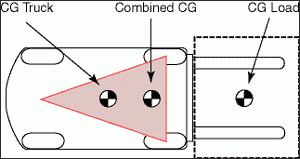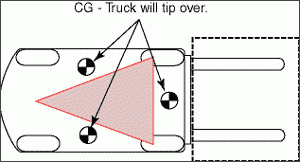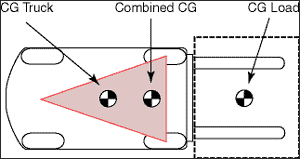Load Handling And Composition On A Forklift – Part V: Stability
When last I wrote on this subject in Load Handling And Composition On A Forklift – Part IV: Balance, we discussed balance and noted that keeping the forklift balanced is essential to preventing accidents, especially tipping over and falling loads. We pointed out that there are two factors that affect forklift balance — center of gravity and shifting center of gravity.

When the vehicle is loaded, the combined center of gravity shifts toward line B-C. Theoretically the maximum load will result in the center of gravity at the line B-C. Actually, the combined center of gravity should never be at line B-C.
In this article, we will discuss how one maintains forklift stability.
Stability of a forklift is based on four principles –- the stability triangle, longitudinal stability, lateral stability, and dynamic stability.
Lateral stability is a lift’s resistance to overturning sideways.
Dynamic stability is when an unloaded forklift’s center of gravity and a loaded lift’s combined center of gravity shifts outside of the stability triangle because of certain movements including sudden stops and starts, turns, or operating on grades. Line of action is an imaginary vertical line through an object’s center of gravity.
Load center is the horizontal distance from the fork’s or other attachments vertical face to the line of action through the load’s center of gravity.
Moment is the product of the object’s weight times the distance from a fixed point. In the case of a lift, the distance is measured from the point at which the lift will tip over to the object’s line of action. The distance is measured perpendicular to the line of action.
The Stability Triangle
Just about every forklift has a three-point suspension system. What that means is that the vehicle is supported at three points. This is so even if the vehicle has four wheels. A pivot pin in the axle’s center attaches the steer axle to the lift. When this point is connected to the front wheels with imaginary lines, this three-point support forms a triangle called the stability triangle. Point A is the pivot

The forklift will not tip over as long as the combined center of gravity of the lift and load system remains within the stability triangle.
point in the rear axle and points B and C are the front wheels. As long as the center of gravity is within the stability triangle, then the lift will remain stable and will not tip over.
When the forklift is not loaded, the location of the forklift’s center of gravity is the only factor to be considered in determining its stability.
When it is loaded, a shift of the center of gravity occurs. The forklift is more stable when it is properly loaded than when it is unloaded. However, improper loading will cause the lift to tip over either laterally on to its side or longitudinally forward. The direction of the tip over depends on where the combined center of gravity shifts outside the stability triangle.
Requirements And Recommended Practices
So when operating the lift:
• Keep the combined center of gravity within the stability triangle.
• Don’t accelerate rapidly, brake suddenly or make sudden changes in direction. This could shift the combined center of gravity outside the vehicle’s stability triangle and destabilize the lift.
- Do not turn rapidly because the combined center of gravity may shift outside the stability triangle and may cause the lift to tip over to the left or right.

If the center of gravity shifts outside the boundaries of the stability triangle, the truck will tip over.• Do not turn rapidly because the combined center of gravity may shift outside the stability triangle and may cause the lift to tip over to the left or right.
• Never turn on a grade or ramp. Even a 10-percent grade may shift the combined center of gravity outside the stability triangle and cause the lift to roll over laterally.
• Cross a railroad track, beam, pothole or other obstacle at a 45-degree angle, so that both wheels do not elevated simultaneously.
• Maintain control of your lift at all times. Adjust your speed to match the conditions and be aware and anticipate dangerous motions and try to avoid them.
• Consider the dynamic forces that cause the vehicle and load into motion. The weight’s transfer and the resulting shift in the center of gravity due to the dynamic forces created when the machine is moving, braking, cornering, lifting, tilting, and lowering loads are important stability considerations.
• When determining whether a load can be safely handled, the operator of the lift should exercise extra caution when handling loads that are close to the truck’s stated capacity. If an operator must handle a maximum load, then the load should be carried at the lowest position possible, the lift should be accelerated slowly and evenly, and the forks of the lift should be tilted forward cautiously.
(Source: OSHA)

